Leak Defense®, a Watts Brand, will host a live APSE-accredited CEU webinar — “Designing Effective Commercial Leak Defense Systems” on Tuesday, September 26th at 12 p.m. ET. Attendees will learn about the different tier levels of leak detection and how designing one of these systems can mitigate the risk associated with water damage from leaks Read more
Watts

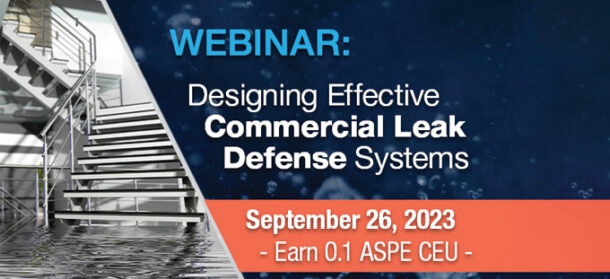
Leak Defense®, a Watts Brand, will host a live APSE-accredited CEU webinar — “Designing Effective Commercial Leak Defense Systems” on Tuesday, September 26th at 12 p.m. ET.
Attendees will learn about the different tier levels of leak detection and how designing one of these systems can mitigate the risk associated with water damage from leaks. Participants can earn 0.1 ASPE CEU that counts toward professional development and licensure requirements.
In this webinar, industry subject matter experts will discuss:
- Why water leak detection is critical in multi-family & commercial structures
- Which buildings are at the greatest risk for leaks and water damage
- Advantages and weaknesses of different types of leak detection systems
- The basic operation of a flow-based leak detection system
- The potential return on investment for a flow-based leak detection system
To register, www.watts.com/LeakDetectionCEU.
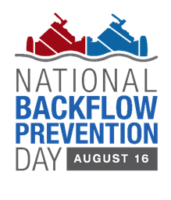
Watts will be hosting a live-streamed event. Tune into the Watts social media channels on August 16th at 2 p.m. ET to discuss how connected technology is changing the landscape of backflow prevention. Coverage to include: Smart and connected backflow solutions New innovations in backflow prevention Behind-the-scenes view of production Interviews with industry professionals – and more Read more
Watts will be hosting a live-streamed event. Tune into the Watts social media channels on August 16th at 2 p.m. ET to discuss how connected technology is changing the landscape of backflow prevention.
Coverage to include:
- Smart and connected backflow solutions
- New innovations in backflow prevention
- Behind-the-scenes view of production
- Interviews with industry professionals – and more
National Backflow Prevention Day day commemorates the tragic backflow incident on the same day which occurred at the 1933 Chicago World’s Fair.
The plumbing industry has rallied around this day to assist in recognizing and honoring backflow preventers – the professionals who ensure our available water supply is free of toxins, waste and harmful chemicals. The holiday aims to spread awareness about the importance of backflow prevention and how the technology is used.
The first backflow incident
It was the summer of 1933. Visitors traveled from points near and far to attend the World’s Fair in Chicago. A water supply was shared by two major hotels that were filled to capacity with tourists. Unaware of the dangerous cross connections in their plumbing system, the two hotels unknowingly allowed amoebic dysentery to spread prolifically throughout their rooms, contaminating the water consumed by their guests.
200 people became severely ill, and 98 of them ultimately lost their lives. This tragic story continues to be a driving factor in backflow innovation. As Watts engineers each new generation of valve, and each new connected feature, we remember that backflow prevention saves lives.
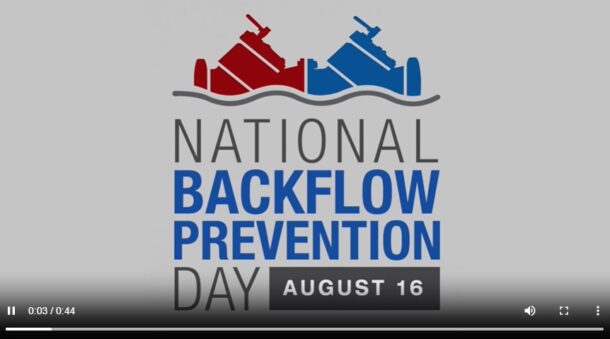
What is National Backflow Prevention Day? National Backflow Prevention Day is a day dedicated to the celebration of backflow prevention and cross-connection control. Backflow preventers are the unsung heroes of water safety as they often go unnoticed, yet play a crucial role in supplying clean and safe water all over the world. Without backflow prevention, people would face the risk of consuming water with toxins, chemicals, waste, and countless other contaminants.
Why is this day being celebrated or observed? The purpose of National Backflow Prevention Day is to acknowledge the importance of backflow prevention, educate the public on how this life-saving technology is used, and to recognize the water quality professionals responsible for installing and maintaining backflow preventers.
How should this day be celebrated or observed? Celebrate National Backflow Prevention day by participating in the following:
- Thank your local plumber or water quality professional for their work
- Attend official National Backflow Prevention Day virtual events
- Locate a backflow preventer in your community, and share an image of it on social media
- Share images of your own backflow and cross-connection installs on social media
Follow Watts on social media channels @wattswater and use #BackflowDay to engage and support the event.
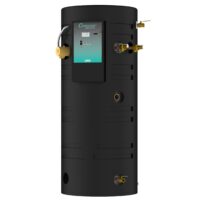
Compact Condensing Water Heaters Bring High Efficiency and Reliability to Commercial Applications up to 1200 MBH PVI, a Watts brand, expands its Conquest® family of compact, condensing, semi-instantaneous, firetube water heaters with 1100 MBH and 1200 MBH units rated for indoor or outdoor applications. With the new, larger-capacity water heaters, the Conquest family supports direct hot water (DHW) demands Read more
Compact Condensing Water Heaters Bring High Efficiency and Reliability to Commercial Applications up to 1200 MBH
PVI, a Watts brand, expands its Conquest® family of compact, condensing, semi-instantaneous, firetube water heaters with 1100 MBH and 1200 MBH units rated for indoor or outdoor applications. With the new, larger-capacity water heaters, the Conquest family supports direct hot water (DHW) demands from 199 MBH to 1200 MBH, for optimal sizing and higher operating efficiency and return on investment (ROI) in new and retrofit commercial applications.
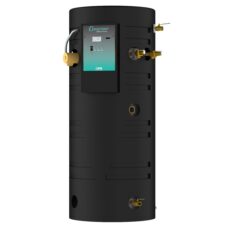 Conquest 1100 and Conquest 1200 water heaters deliver high efficiency through a completely submerged, single-pass, down-fired design, which includes an array of helical fire tubes. Combustion gases are counter-flow to the direction of the potable water, enabling the coolest flue gases to contact the coldest water and raise low-fire efficiency to 99%.
Conquest 1100 and Conquest 1200 water heaters deliver high efficiency through a completely submerged, single-pass, down-fired design, which includes an array of helical fire tubes. Combustion gases are counter-flow to the direction of the potable water, enabling the coolest flue gases to contact the coldest water and raise low-fire efficiency to 99%.
To reduce burner cycling during periods of low hot water demand, Conquest water heaters employ burner modulation with a variable speed blower. This allows low flow conditions to be met with continuous, low BTU input and without short-cycling. The reduction in energy input also helps achieve the exceptional thermal efficiency while lowering operating costs. During periods when nominal demand is only a few gpm, the at-temperature storage capacity of the Conquest can meet the hot water requirement for 20-40 minutes before a burner cycle is required.
Built from the finest materials, the Conquest 1100 and Conquest 1200 provide superior ROI with 3-5 times the warranty of competitors. The water heaters feature a submerged combustion chamber and heat exchanger with a dimpled array of firetubes fabricated entirely from durable AquaPLEX® duplex stainless steel alloy. Unlike 316L stainless steel, the AquaPLEX tank is inherently immune to chloride stress corrosion cracking and eliminates the need for a tank lining or anode rods.
An electronic operating control provides a plain-text user interface that indicates heater status, modulation rate, operating parameters, and fault status to facility managers and owners. The control is embedded with Modbus RTU and BACnet MS/TP protocols for straightforward connection to a building automation system (BAS).
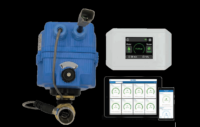
What the Customer Needed This homeowner from Riverwoods, Illinois spends a lot of time away from home. In order to have confidence that his home was protected while he was not there, he decided to get a plumbing leak detection system installed for extra peace of mind. Solution The homeowner hired Ravinia Plumbing in Lincolnshire Read more
What the Customer Needed
This homeowner from Riverwoods, Illinois spends a lot of time away from home. In order to have confidence that his home was protected while he was not there, he decided to get a plumbing leak detection system installed for extra peace of mind.
Solution
The homeowner hired Ravinia Plumbing in Lincolnshire, Illinois, to install The Leak Defense System®. Once it was in place, the system’s control panel showed that significant water was running constantly within the house.
The homeowner and the system installer walked the entire house inside and out looking for a leak, checking each toilet and all other potential leak sources. Three toilet flappers, which seal the opening between the water storage tank and the toilet bowl, were found to be leaking and needed to be replaced.
In addition, they found that a whole house humidifier had a bad solenoid valve (which controls the water flow from the reservoir to the evaporator system). Normally, the valve is closed until humidity drops below a set level. However, due to the faulty valve, water was constantly running through it. “We were NOT aware where or why [the leaks were occurring],” the homeowner said.
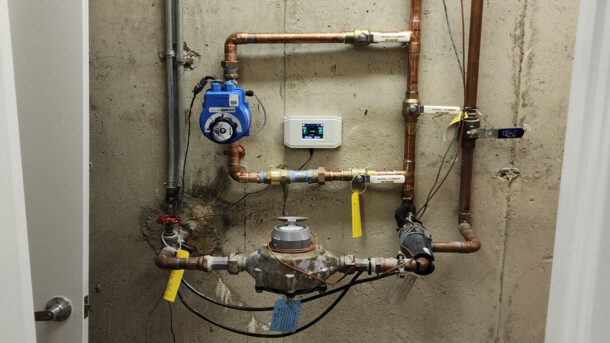
Installing Leak Defense
Following a third incident when a hot water tank line sprung a leak in a pantry, the building maintenance engineer suggested several leak detection solutions to the Building Governance Committee. Among the suggestions was The Leak Defense System®, which the committee, chaired by Pusateri, ended up choosing.
The system contains several components. The first is a Leak Defense System® Valve, which is installed on the incoming waterline to each condo unit. Once installed, the automatic water shut-off control valve monitors water flow 24/7/365.
The second is a wireless touchscreen Control Panel in each unit, which allows residents to set the system to fit their family’s lifestyle needs. For example, if high-volume overnight water usage would be unusual, the Control Panel can send an audible alert if significant water is flowing in the middle of the night, and it can shut off the water intake. The Control Panel can also be connected to a third-party monitoring company to make sure an alert gets attention, even if the condo owners are away.
Results
The toilet flappers were replaced, and a new humidifier solenoid valve was installed. Since the Leak Defense System® installation, the control panel has picked up no further leaks. Had these issues not been fixed, “each could have led to serious issues in the house,” the homeowner said and has reduced needless water waste at the home. The system has provided this homeowner the extra peace of mind his home is safe from plumbing leaks while he is away.
To learn more, visit LeakDefense.com.

Watts has announced a new webinar: New Tech in Backflow Prevention: The Future is Now. It’s ASPE-accredited and worth 0.1 CEUs. On Wednesday, August 16, 2023, 12:00 p.m. ET., participants will learn about: What backflow is and why it is required The principals of continuous monitoring Understanding connectivity considerations and options The nuances of indoor Read more
Watts has announced a new webinar: New Tech in Backflow Prevention: The Future is Now. It’s ASPE-accredited and worth 0.1 CEUs.

On Wednesday, August 16, 2023, 12:00 p.m. ET., participants will learn about:
- What backflow is and why it is required
- The principals of continuous monitoring
- Understanding connectivity considerations and options
- The nuances of indoor vs. outdoor installs
- Sustainability in backflow prevention
Visit watts.com/BackflowDayCEU to register.

